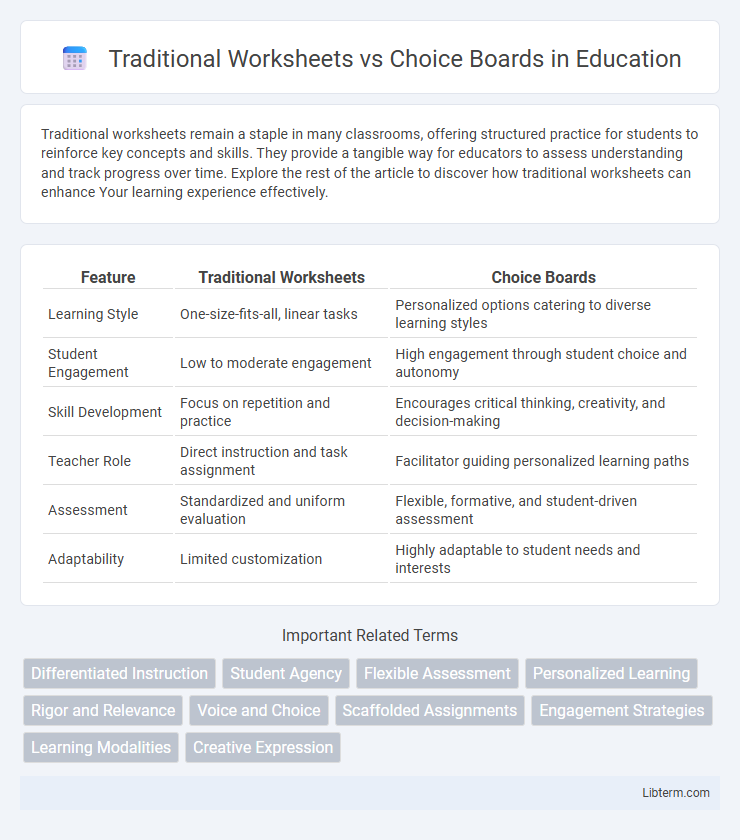Traditional worksheets remain a staple in many classrooms, offering structured practice for students to reinforce key concepts and skills. They provide a tangible way for educators to assess understanding and track progress over time. Explore the rest of the article to discover how traditional worksheets can enhance Your learning experience effectively.
Table of Comparison
| Feature | Traditional Worksheets | Choice Boards |
|---|---|---|
| Learning Style | One-size-fits-all, linear tasks | Personalized options catering to diverse learning styles |
| Student Engagement | Low to moderate engagement | High engagement through student choice and autonomy |
| Skill Development | Focus on repetition and practice | Encourages critical thinking, creativity, and decision-making |
| Teacher Role | Direct instruction and task assignment | Facilitator guiding personalized learning paths |
| Assessment | Standardized and uniform evaluation | Flexible, formative, and student-driven assessment |
| Adaptability | Limited customization | Highly adaptable to student needs and interests |
Understanding Traditional Worksheets
Traditional worksheets typically consist of structured questions and exercises designed to reinforce specific skills or concepts, often emphasizing rote memorization and repetitive practice. They provide a clear, linear format that helps educators assess individual student knowledge in subjects like math, reading, or science. However, traditional worksheets may lack engagement and adaptability, making it difficult to cater to diverse learning styles and promote critical thinking.
What Are Choice Boards?
Choice boards are interactive learning tools that provide students with a variety of activity options to demonstrate understanding, catering to different learning styles and preferences. Unlike traditional worksheets that offer uniform tasks, choice boards empower learners by promoting autonomy and engagement through personalized selection. These boards often incorporate multimedia, critical thinking challenges, and creative assignments to foster deeper comprehension and student motivation.
Comparing Instructional Approaches
Traditional worksheets emphasize repetitive practice and direct skill reinforcement, offering structured tasks that target specific learning objectives. Choice boards provide a flexible framework, allowing students to select activities that cater to diverse learning styles and promote engagement through autonomy. Comparing these instructional approaches reveals that choice boards can enhance motivation and creativity, while worksheets maintain consistency and focus on mastery of foundational content.
Student Engagement and Motivation
Traditional worksheets often result in passive learning experiences, limiting student engagement and reducing motivation due to repetitive tasks and lack of choice. Choice boards enhance student engagement by offering personalized learning paths that cater to individual interests and learning styles, increasing intrinsic motivation. Research shows that students using choice boards demonstrate higher participation rates and improved attitudes toward learning compared to those relying solely on traditional worksheets.
Differentiation and Personalized Learning
Traditional worksheets often follow a one-size-fits-all approach, limiting opportunities for differentiation and personalized learning by providing uniform tasks to all students. Choice boards, in contrast, offer varied activities tailored to diverse learning styles, allowing students to select tasks that match their interests and skill levels, thus promoting engagement and individualized growth. This flexibility supports educators in addressing unique learner needs and fostering intrinsic motivation through meaningful, student-centered learning experiences.
Assessing Student Outcomes
Traditional worksheets primarily assess student outcomes through repetitive practice and straightforward question formats, enabling teachers to evaluate basic understanding and procedural skills efficiently. Choice boards offer a more dynamic assessment by allowing students to select tasks that match their learning styles and interests, promoting critical thinking and deeper comprehension. This differentiated approach helps educators gain insight into individual student strengths, creativity, and problem-solving abilities beyond standard recall.
Classroom Management Considerations
Traditional worksheets often lead to passive student engagement, increasing classroom management challenges such as off-task behavior and disengagement. Choice boards promote active participation by offering students autonomy and varied learning activities, which enhances focus and reduces disruptive incidents. Effective classroom management benefits from implementing choice boards that cater to diverse learning preferences, fostering a more controlled and motivated learning environment.
Teacher Preparation and Planning
Teacher preparation for traditional worksheets often involves creating or selecting repetitive, skill-focused tasks that align with standardized curricula, requiring less differentiation. Choice boards demand more intricate planning, as teachers must design diverse, student-centered activities that cater to varied learning styles and promote autonomy. This increased complexity in planning supports differentiated instruction and personalized learning pathways.
Technology Integration in Practice
Traditional worksheets often limit technology integration in practice by emphasizing paper-based tasks that lack interactivity and real-time feedback. Choice boards enhance technology integration by allowing students to select digital activities tailored to their learning styles, incorporating multimedia tools and online resources. This approach fosters student engagement and personalized learning through seamless access to educational apps, interactive quizzes, and collaborative platforms.
Choosing the Best Strategy for Your Classroom
Traditional worksheets offer structured practice and straightforward assessment, ideal for reinforcing specific skills and ensuring curriculum alignment. Choice boards promote student autonomy and engagement by allowing learners to select tasks that match their interests and learning styles, fostering creativity and critical thinking. Selecting the best strategy depends on classroom goals, student needs, and the desired balance between guided practice and personalized learning experiences.
Traditional Worksheets Infographic

 libterm.com
libterm.com